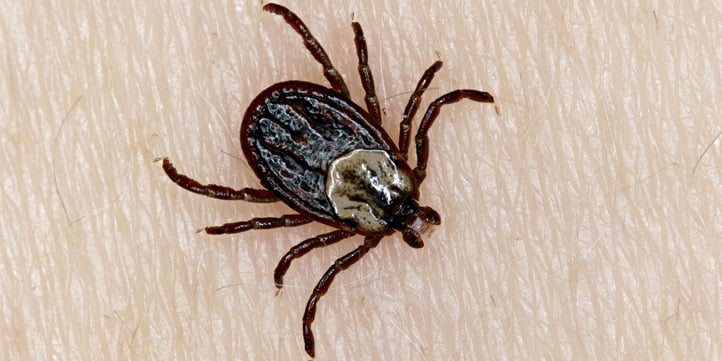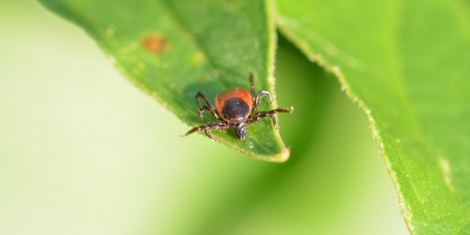
Ticks are just another thing to worry about, right? Well, yes. But the more you know about them, the more equipped you'll be to prevent tick bites and not worry about them while enjoying yourself outside.
Here are 10 quick facts about these tiny terrors.
1. Ticks Are Arachnids

You might've thought that ticks were classified as insects, but they're actually arachnids.
That means they're more closely related to spiders and scorpions than mosquitoes or flies. Ticks are small arachnids, belonging to one of two families; hard ticks - Ixodidae - which are incredibly difficult to crush, or soft ticks - Argasidae - which don't have the hard, protective shield that their cousins have.
RELATED > What Are Ticks And Why Should I Care?
They've all got eight legs, and have four life stages; egg, larva, nymph, and adult.
2. There are around 800 species of ticks worldwide.
Damn, that's a lot of ticks!
Ticks live in your favourite outdoor havens, including the woods, beaches, provincial and national parks, or grassy fields.
In Canada, around 40 species have so far been found. Particular risk areas include eastern Canada and Manitoba, as well as areas with large deer populations.
3. Ticks are ectoparasites.

Just like a vampire, ticks get their kicks out of sucking your blood. In fact, they need blood to survive, and all sorts of blood will do.
Birds, reptiles, cats, dogs... yours. Ectoparasites are organisms that live on the outside of other animals (or humans), inserting their mouthpart in order to extract the blood they need for sustenance. What a life.
4. A tick could feed on you for a few days, if you let them.
Unlike mosquitoes, who bite, suck, and move on, ticks like to get the most out of you.
Once they've found a spot they like, they'll stick their head in, inject a blood-thinning agent to make your blood easier to extract, and get comfortable for 2 or 3 days, continually swelling with the more blood they consume.
5. There's a Lyme disease vaccine for dogs, but not for humans.

According to the Canadian Lyme Disease Foundation, dogs can be vaccinated against Lyme disease, but the vaccine is still quite new and controversial.
A veterinarian will only recommend vaccinating your dog if you live in a tick-infested area.
RELATED > How To Protect Pets From Tick Bites
Unfortunately, there is no vaccine for Lyme disease in humans just yet, so tick control methods are especially important.
6. Ticks can spread multiple diseases at one time.

Since ticks don't strictly dine on humans, they tend to pick up different viruses and diseases, as they switch from horse to mouse to dog to deer.
RELATED > How Ticks Transmit Lyme Disease
Ticks have been known to transmit a number of diseases at once. A blacklegged tick, for example, could pass on Lyme disease, anaplasmosis, and babesiosis all in the one bite. Yikes.
7. Ticks can still bite you in Winter.
Freezing temperatures don't kill ticks.
As long as it's consistently above 7 degrees C, ticks will be ready to bite.
8. Ticks like to crawl upwards.

Ticks don't fly or jump. Instead, they'll strategically wait around on tall grasses or wood piles and latch on to you, your pet, or another animal as you brush past them.
Once they've latched on to you, they'll crawl upwards and find a suitable place to stick their head in. They prefer skin which is thinner, as it makes insertion all the more easier.
Places like the head, neck, and ears are hot spots; that's why the most common place to find a tick on your dog is on their ears.
9. You've got around 36 hours to find & remove a tick before it transmits an infection.
We've said it before and we'll say it again. When you come back from a tick prone area, check yourself... before you wreck yourself.
It takes roughly 36 to 48 hours for Lyme disease bacteria to be transmitted. Make sure you strip down and take a look for the odd tick that might've made a home on you, and do the same for your kids and pets.
If you find a tick, make sure you remove it with tweezers, disinfect the area, save the tick, and bring it to your nearest health care provider for testing.
10. In Canada, Lyme disease is on the rise.

Lyme disease incidence has been steadily climbing over recent years.
Canada monitors Lyme disease through provincial reports of Lyme disease, voluntary tick submissions, and active surveillance in the field. Last year, there were 841 cases of Lyme disease, which is more than double the number 5 years ago.
Well, there you have it. How many of these little facts did you know? Be sure to follow us on Facebook for more tick control and mosquito control tips.



